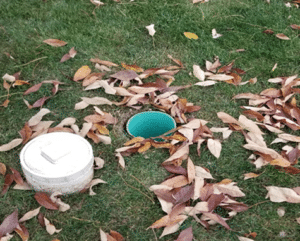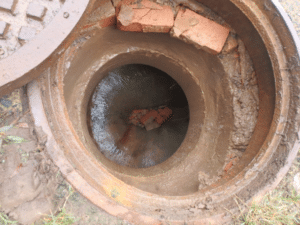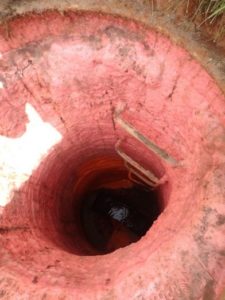

The collection, conveyance, and treatment of sanitary sewer flow for a Municipality, Authority, or Sewer Utility Provider can be a costly process. Every gallon of wastewater that enters a sewer system must be transported and treated somewhere. Adding to this expense is Inflow & Infiltration, which increases the volume of wastewater flow that requires conveyance and treatment. In this blog post, we will explain what I&I is, where it comes from, and cost-effective methods to eliminate it.
What is Inflow & Infiltration (I&I)?
Inflow and Infiltration, commonly referred to as I&I, is excess water flowing into your sanitary sewer system.
Inflow is typically a form of stormwater runoff from existing grade that gets into the sewer system, usually from cracks inside the manhole or damage to the manhole chimney, frame, or cover. Other forms of Inflow include illegal sump pump discharges or roof downspout connections to the sanitary sewer system, or damaged cleanouts at surface level associated with building laterals. Inflow typically occurs during or immediately following a storm event.
Infiltration is commonly considered groundwater that leaks into your collection or conveyance system under the surface via separated pipe joints or cracks in the sewer system. Infiltration can happen at any time (including sunny days!), based on the groundwater level relative to the sewer pipe depth, but generally occurs during rainfall or snowmelt events that cause the groundwater level to rise.
Sources of I&I
There are many sources of I&I. Common defects that lead to I&I within a sewer system include (but are not limited to) the following:
INFLOW

- Manhole Cracks and/or Leaking Joints
- Damage to Manhole Chimney (Riser Adjustment Rings), Frame, or Cover
- Illegal Sump Pump or Roof Downspout Connections
- Improper Grading or Paving Around Manholes Lids
- Damaged and/or Low-Lying Cleanout Stacks
- Manholes Located In or Near Waterways or Drainage Swales
INFILTRATION

- Cracks in Sewer Main Piping
- Pipe Joint Separation
- Root Intrusion
- Offset Pipe Joints
- Pipe Wall Deterioration including Partial Collapse
Whatever the cause, defects within the sanitary sewer system lead to Inflow & Infiltration, resulting in additional wastewater flow within the sewer system, higher energy use to transport and treat the added flow, and overall higher operating costs. Reducing and/or eliminating I&I should be a top priority for any Municipality, Authority, or Sewer Utility Provider.

Reduction and/or Elimination of Inflow and Infiltration
There are many methods to reducing and/or eliminating inflow and infiltration, but most approaches fall into one of three major categories: Identification, Evaluation. & Rehabilitation.
IDENTIFICATION
Before I&I can be eliminated, it needs to be identified. Methods to identify I&I can range from sewage flow monitoring capabilities, sewer televising services, manhole condition assessments, cleanout inspections.
- Flow Monitoring Capabilities – A metering study is conducted to quantify the volume of flow within a specific sewer service area. Typically, a flow monitoring device such as an ultrasonic meter or pressure transducer is used to measure the depth of flow within the manhole channel, which can be used to calculate the instantaneous flow rate within the sewer pipe. By correlating this information with rainfall data from the same area, flow monitoring can help indicate areas of increased flow during rainfall events – a likely sign of I&I – and help narrow the investigation. As an added benefit, areas that do not show correlation with rainfall events can suggest I&I is not present within a tributary area, eliminating the need for additional investigation such as cleanout inspections or Sewer Televising Services in these areas.
- Sewer Televising Services – A visual inspection of the pipe interior between two manholes within the sewer system. A televising crew uses a self-propelled
 camera, usually on a motorized skid with an adjustable camera, to record a video of the pipe interior as the camera progresses along the sewer main. A defect summary report is typically generated at the end of the televised inspection, including screen captures of individual defects and linear measurement of distance (Stationing) from the starting manhole.
camera, usually on a motorized skid with an adjustable camera, to record a video of the pipe interior as the camera progresses along the sewer main. A defect summary report is typically generated at the end of the televised inspection, including screen captures of individual defects and linear measurement of distance (Stationing) from the starting manhole. - Manhole Condition Assessments – A visual inspection of the manhole interior, including the interior wall integrity of the structure, evidence of current or past leaking at wall joints, and sewer pipe penetrations into the manhole. Visual inspection of the manhole chimney, frame, and cover is also conducted. A summary report is typically generated, including any defects noted, along with a sketch detailing pipe diameter, material, and general orientation within the manhole. As a cost-savings measure, the condition assessment can be completed in conjunction with the Sewer Televising Services.
- Cleanout Inspections – A field inspection of the cleanout stacks, typically focused in residential neighborhoods, to identify any necessary repairs. The visual inspection includes the physical condition of the cleanout, including any damage to the riser pipe or cap, as well as if it is situated at or below-grade, which can be a source of inflow.
EVALUATION
Now that sewer defects within the service area have been identified, how do you determine what to repair and when?
Preferably, every defect identified would be immediately repaired, as any defect can lead to Inflow and Filtration and higher wastewater flows, but real-world constraints such as funding, access, and schedule may require repairs to be prioritized.
Choosing the right consultant is paramount when determining how best to approach sewer defect repairs. Carroll Engineering Corporation proudly maintains our certification in the National Association of Sewer Service Companies (NASSCO) Pipeline Assessment Certification Program (PACP), which allows us to best advise our clients with objective recommendations. PACP allows for consistent and reliable information to be collected during mainline inspections. NASSCO developed PACP in 2002. Before its development, there was no industry-wide standard inspection procedures or codes used in the United States. This made it difficult to compare defects and prioritize repairs when reviewing reports prepared by different contractors. PACP standardized the methodology to inspect sanitary sewer mains, including standardized forms and a matrix of codes to identify what is observed.
In addition to standardized defect identification, under PACP, each defect is assigned a condition grade. Defect grades are assigned in two categories, structural, and operation and maintenance (O&M). The grade scale goes from 1 (minor defect grade) up to 5 (most significant defect grade). Once the inspection is completed, the defect grades are used to provide four-digit quick ratings in both the structural (QSR) and maintenance (QMR) categories. Quick ratings provide the quantity of defects at the two highest severity grades. For example, if a pipe is observed to have a hole with soil visible (structural defect grade 5), a large joint offset (structural defect grade 4), and a section of surface damage with aggregate missing (structural defect grade 4), it would have a QSR of 5142. A sewer that has no structural defects, but there are encrusted deposits or grease obstructing <10% of the main (O&M grade 2) and fine roots observed at eight joints (O&M grade 1) would have a QSR of 0000 and a QMR of 2118.
NASSCO has also developed the Manhole Assessment Certification Program (MACP) and Lateral Assessment Certification Program (LACP) to apply the same standards to inspections of these components of the sewer system.
The NASSCO PACP/LACP/MACP methodologies provide objective and quantitative systems for ranking defects within a sewer system. Properly prepared reports combined with an engineering assessment can be used to prioritize defects and develop recommendations for rehabilitation or replacement of portions of the sewer system.
REHABILITATION
Once a priority list for defect repairs has been developed, the proper method of rehabilitation should be determined. Repairs can consist of open trench excavation for pipe replacement, trenchless options such as slip-lining or pipe bursting, or less intrusive methods such as manhole lining, chimney repairs, or inflow dishes.
- Open Trench Excavation – Depending on the level of severity of pipe defects along a sewer run, as well as other considerations such as the age and pipe material of the sewer, excavation & replacement of the existing sewer may be the best alternative to address sewer repairs. Although potentially more costly than other alternatives when factoring in excavation, pipe material and/or manhole installation, backfill, & restoration, this repair method provides brand-new sewer upon completion. It is likely this alternative will have a significant impact on I&I reduction in the short and long term.
- Trenchless Pipe Rehabilitation – Less invasive than open trench excavation, trenchless pipe installation eliminates much of the need for excavation, backfill, & restoration, especially in longer sewer runs. Trenchless technologies do typically require a sending and receiving pit, however, so not all site construction is avoided. Numerous trenchless technologies are available based on the needs of the project, including the following:
- Directional Drilling – the use of an auger to drill an opening while pulling a pipe behind the unit. Directional drilling is often used for smaller diameter sewage force main piping.
- Jack & Boring – A hydraulic machine pushes a large casing pipe underground between a sending & receiving pit on either end of the sewer run. The new sewer pipe is installed within the casing pipe. Typically used for larger diameter force main piping, although it can also be used for gravity sewer applications.
- Cured-in-Place-Pipe (CIPP) – A true trenchless technology that avoids excavation, a hydraulic machine pulls a smooth, flexible liner between two existing manholes. Once in place, a balloon within the liner is inflated, and the liner is cast into place. Once set, the thin hard liner has a smooth continuous interior and eliminates any pipe joints. A machine is then used to cut open lateral connections from within the pipe.
- Slip-Lining – Typically used for sewer mains with partially separated joints and/or root intrusion, a hydraulic machine pushes a hard-walled seamless pipe (typically HDPE) between an excavated sending & receiving pit on either end of the sewer run. The pipe has a smooth continuous interior, which offsets the reduction in pipe diameter, and eliminates any pipe joints. Existing lateral connections are then excavated near the main and reconnected.
- Pipe Bursting – Typically used for sewer mains with offset joints or to install larger diameter pipe, a bursting tool (A hydraulic or pneumatic-driven expansion head) is forced along an existing pipeline to break up the existing main, while pulling a new pipe behind it. The new pipe (typically HDPE) is usually butt-welded or similar to provide a seamless sewer main without pipe joints.
- Manhole Repairs – Depending on the type of defect noted, there are various methods to repair manholes, including manhole liners, chimney coatings, and inflow dishes.
- Manhole Lining – Beneficial to repair large portions of the manhole interior, or to protect existing or new manholes from sewer gases discharged from pump station force mains, manhole lining includes a coating system to protect the concrete structure.
- Chimney coating –A concrete or epoxy coating is applied to the chimney to prevent inflow under the manhole frame and cover. The chimney typically consists of manhole adjustment rings, brick, block, or other material that make up the vertical difference between the top of the concrete manhole and the roadway.
- Inflow Dishes– A plastic dish (usually HDPE) that sits within the manhole frame directly below the cover. The dish is used to collect stormwater runoff that gets under the manhole cover before flowing into the sanitary sewer system.
How Carroll Engineering Can Help
Carroll Engineering Corporation (CEC) has extensive experience in the identification, evaluation, and rehabilitation of inflow and infiltration (I&I) within sanitary sewer collection and conveyance systems. We offer a wide range of services to help evaluate the condition of your system, including but not limited to sewage flow monitoring capabilities, sewer televising services, manhole condition assessments. Once defects have been identified, we can offer a multitude of repair options, ranging from manhole linings to open-trench pipe replacement to trenchless technologies such as pipe bursting or slip-lining. CEC can also provide full design services associated with rehabilitation work, including plan preparation, project specifications, bidding, and construction administration & observation services.
For more information or questions relating to inflow and infiltration, and how Carroll Engineering can help with your next project, please contact Michael McCarey, P.E., Water & Wastewater Assistant Manager at mmccarey@carrollengineering.com or call 215-343-5700 ext 354.
